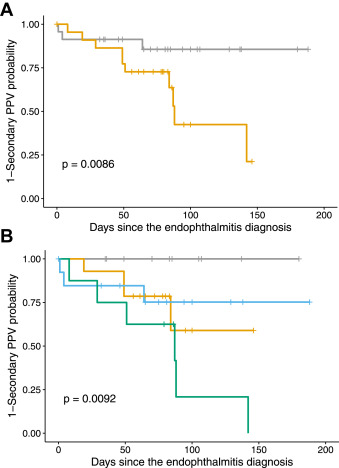Endophthalmitis is a rare but significant potential complication of eye surgery that can result in a substantial loss of vision. Microbial culture remains the gold standard for detecting organisms associated with endophthalmitis, but in 30% of cases no organism is identified. Molecular testing such as PCR or deep DNA sequencing have been increasingly used in ophthalmology, and can identify and characterize pathogens with unprecedented detail. We sought to apply these techniques to a prospective cohort of patients with endophthalmitis and correlate the findings with clinical outcomes, to determine whether they provide additional prognostic information for the management of post-procedure endophthalmitis.
We enrolled 50 patients with endophthalmitis in the study. A total of 24 samples were found to be culture-positive and 26 were culture-negative. The patients' visual acuity was tested at baseline, at one month, and at 3 months. We found that patents with negative culture and whole genome sequencing results and those who were positive for S. epidermidis had superior clinical outcomes compared those patients who were positive for other pathogens. In addition, a higher quantitative bacterial load of non-S. epidermidis pathogens corresponded to worse outcomes.
We also tested the samples for the presence of torque teno virus (TTV) using using the biome representational in silico karyotyping (BRiSK) technique. TTV is a small, non-enveloped, single stranded, circular DNA virus associated with numerous diseases involving blood, immune system, respiratory system, or cancers but has not been shown to be causative of any of these. We found TTV in nearly half of the endophthalmitis samples. The presence of TTV was associated with an increased risk of need for secondary vitrectomy, particularly in cases that were also culture-positive. All of the patients that required a secondary vitrectomy for retinal detachment had TTV at presentation.

Taken together, these results suggest that WGS sequencing and directed PCR can provide improved prognostic information in post-procedural endophthalmitis. The culture/molecular pathogen testing status (for bacteria and virus) as well as baseline visual acuity of patients with endopthalmitis have prognostic significance for clinical outcomes including visual acuity and secondary vitrectomy.
Lee CS, Hong B, Kasi S, Aderman C, Talcott K, Adam M, Yue B, Akileswaran L, Nakamichi K, Wu Y, Rezaei KA, Olmos de Koo LC, Chee YE, Lee AY, Garg SJ, Van Gelder RN, Endophthalmitis Study Group. Prognostic utility of whole genome sequencing and polymerase chain reaction tests of ocular fluids in post-procedural endophthalmitis. American journal of ophthalmology. Am J Opthalmol. 2020 Mar 23. pii: S0002-9394(20)30106-9. doi: 10.1016/j.ajo.2020.03.008. [Epub ahead of print] PMID: 32217118

